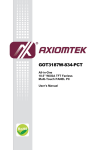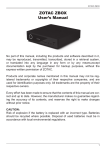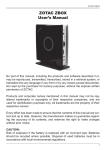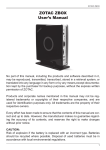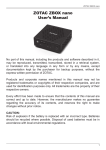Download User Guide
Transcript
Intel NUC Kit NUC5PGYH User Guide Intel® NUC Kit NUC5PGYH User Guide 1 Intel NUC Kit NUC5PGYH User Guide Before You Begin CAUTIONS The procedures in this user guide assume familiarity with the general terminology associated with personal computers and with the safety practices and regulatory compliance required for using and modifying electronic equipment. Disconnect the computer from its power source and from any telecommunications link or network before performing any of the procedures described in this guide. Failure to disconnect power, telecommunications links, or networks before you open the computer or perform any procedures can result in personal injury or equipment damage. Some circuitry on the board can continue to operate even though the front panel power button is off. Follow these guidelines before you begin: Always follow the steps in each procedure in the correct order. Set up a log to record information about your computer, such as model, serial numbers, installed options, and configuration information. Electrostatic discharge (ESD) can damage components. Perform the procedures described in this chapter only at an ESD workstation using an antistatic wrist strap and a conductive foam pad. If such a station is not available, you can provide some ESD protection by wearing an antistatic wrist strap and attaching it to a metal part of the computer chassis. Installation Precautions When you install and test the Intel NUC, observe all warnings and cautions in the installation instructions. To avoid injury, be careful of: Sharp pins on connectors Sharp pins on circuit boards Rough edges and sharp corners on the chassis Hot components (such as SSDs, processors, voltage regulators, and heat sinks) Damage to wires that could cause a short circuit Observe all warnings and cautions that instruct you to refer computer servicing to qualified technical personnel. Observe Safety and Regulatory Requirements If you do not follow these instructions, you increase your safety risk and the possibility of noncompliance with regional laws and regulations. 2 Intel NUC Kit NUC5PGYH User Guide This guide tells you how to: • • • • • • Install a 2.5” drive (optional) Upgrade memory (optional) Install a VESA mount bracket (optional) Set up Microsoft® Windows® 10 Keep BIOS and drivers current Operating system recovery Install a 2.5” SSD or Hard Drive (Optional) For a list of tested 2.5” hard drives, go to the Tested Peripherals page on the Support site. Follow these instructions to install a 2.5” Solid State Drive (SSD) or Hard Disk Drive (HDD): 1. Observe the precautions in "Before You Begin" on page 2. 2. Open the Intel NUC chassis by unscrewing the four corner screws on the bottom cover of the chassis and lift the cover. 3 Intel NUC Kit NUC5PGYH User Guide 3. Slide the 2.5” drive into the drive bay, ensuring the SATA connectors are fully seated into the connectors of the SATA daughter card (A). 4. Secure the drive into the drive bay with the two small silver screws that were included in the box (B). 5. Set the drive bay bracket down inside the chassis (C), taking care not to pinch the SATA cables along the edge. 4 Intel NUC Kit NUC5PGYH User Guide Upgrade Memory Intel NUC Kit NUC5PGYH has a 2GB DDR3L memory module already installed. You can upgrade to a larger capacity module if you wish. Memory requirements: 1.35V low voltage memory 1066 MHz or 1600 MHz SO-DIMMs (1333 MHz modules will operate at 1066 MHz) Non-ECC Max memory – 8GB For a list of tested memory, go to the System Memory page on the Support site: To upgrade memory: 1. Remove the pre-installed SO-DIMM, following these steps: a. Observe the precautions in "Before You Begin" on page 2. b. Gently spread the retaining clips at each end of the SO-DIMM socket. The SO-DIMM pops out of the socket. c. Hold the SO-DIMM by the edges, lift it away from the socket, and store it in an anti-static package. d. Reinstall and reconnect any parts you removed or disconnected to reach the SO-DIMM sockets. e. Replace the computer’s cover and reconnect the AC power cord. 2. Install the new SO-DIMM, following these steps: a. Align the small notch at the bottom edge of the SO-DIMM with the key in the socket (A). b. Insert the bottom edge of the SO-DIMM into the socket. c. When the SO-DIMM is inserted, push down on the outer edge of the SO-DIMM (B) until the retaining clips snap into place. Make sure the clips are firmly in place (C). 5 Intel NUC Kit NUC5PGYH User Guide Close the Chassis After all components have been installed, close the Intel NUC chassis. Intel recommends this be done by hand with a screwdriver to avoid over-tightening and possibly damaging the screws. Attach and Use the VESA Bracket (Optional) Follow these instructions to attach and use the VESA mount bracket: 1. Using the four small black screws that were included in the box, attach the VESA bracket to the back of the monitor or TV. 6 Intel NUC Kit NUC5PGYH User Guide 2. Attach the two slightly larger black screws to the bottom chassis cover of the Intel NUC. 3. Slide the Intel NUC onto the VESA mount bracket. Set Up Microsoft® Windows® 10 Microsoft Windows 10 is already installed on the Intel NUC Kit NUC5PGYH. The first time you start the computer, you are guided through the following Setup steps: 1. 2. 3. 4. 5. 6. 7. 7 Select your region and language. Accept the Microsoft Windows license terms. Personalize Windows and assign a PC Name. "Get Online" dialog to pick a wireless network (this step is optional). Choose Express Settings or Customize. Assign a User Name and Password. Finished. Intel NUC Kit NUC5PGYH User Guide Keep BIOS and Drivers Current To download the latest BIOS and drivers, go to Download Center. Refer to BIOS Update Instructions for information on updating the BIOS for your Intel NUC. Drivers are available for the following features: Audio Bluetooth Chipset Consumer Infrared Graphics Intel® TXE Intel® Ready Mode Technology LAN (wired and wireless) NFC Serial I/O USB 3.0 Operating System Recovery There is a Windows recovery partition on the Intel NUC. You can use this partition to Refresh, Reset, or Restore Windows. Here is what each of these actions do: Refresh If your PC isn't performing as well as it once did, and you don't know why, you can refresh your PC. This action does not delete any of your personal files or change your settings. Refresh does the following: Reset If you want to recycle your PC, give it away, or start over with it, you can reset it completely. This process removes everything. Reset does the following: Restore Files and personalization settings won’t change. PC settings are changed back to their defaults. Apps from the Windows Store are kept. Apps installed from disks or websites are removed. List of removed apps is saved on the desktop. All personal files and apps are removed. PC settings are changed back to their defaults. Windows is reinstalled. If a recently installed app or driver is causing problems with your PC, you can restore Windows back to an earlier point in time, called a restore point. System Restore doesn’t change your personal files, but it can remove recently installed apps and drivers. Caution - Before performing a reset or refresh: 8 Make sure to back up all personal data to external storage. Remove SD card from the card slot, if one is inserted. Intel NUC Kit NUC5PGYH User Guide To access the recovery media: If Windows starts From Windows Start, type Recovery and select Recovery Options. See Recovery options in Windows 10 for complete details on how to use the recovery options. If Windows does not start The recovery process should automatically start. If Recovery does not automatically start, you can try to initiate it as follows: 1. Press F8 during boot, when you see the prompt “F8 to Activate Windows 8.1/10 Recovery Mode”. 2. Follow the recovery steps. 9









